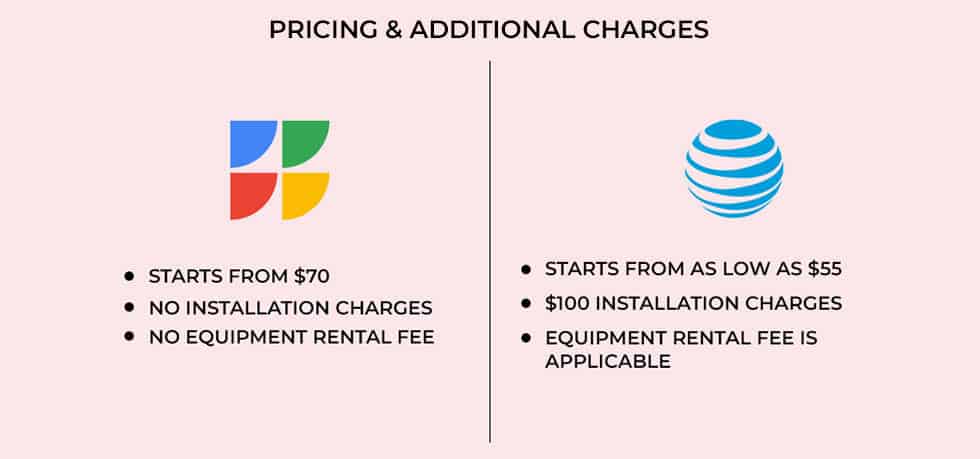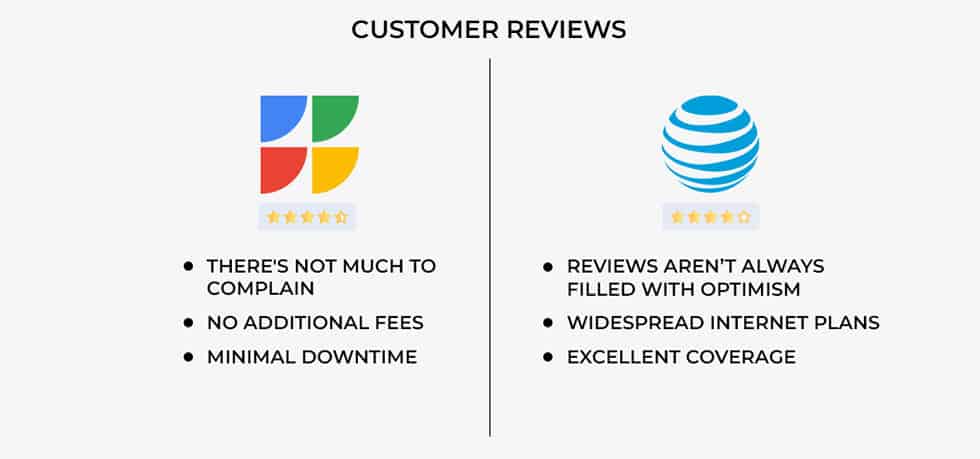If you've access to high-speed fiber connections from Google and AT&T, you are supposed to be confused about choosing between the two.
To start with, AT&T still has to cover some remote areas, whereas Google is making quite an impression with its relatively new line of fiber-based internet plans.
Therefore, comparing Google Fiber and AT&T Fiber across diverse parameters is appropriate, especially to establish an internet enrolment context.
I used these Fiber services simultaneously at home, only to compare and contrast them as per the choice of plans, speeds, pricing, reliability, and more. So let us not waste more time and deep dive into the fiber-based specifics.
Key Differences Between Google Fiber & ATT Fiber
Pressed for time? Well, you can quickly go over these few essential differentiating points to be able to make better and more informed decisions:
The Key Differences between ATT Fiber and Google Fiber
Speeds: AT&T offers a more widespread choice of internet service plans, unlike Google. With AT&T, you can get internet plans as basic as 300 Mbps or as fast as 5 Gbps, unlike Google, which peaks at 8 Gbps max.
Installation Fees: Google Fiber doesn’t attract additional charges. However, AT&T requires you to pay close to $100 for professional installation and around $10 for equipment rental.
Price: If you want more control over your next internet plan’s affordability, I recommend AT&T over Google Fiber Internet. ATT fiber pricing is a bit on the excessive side.
Coverage or Availability: AT&T boasts wider availability. Google Fiber’s internet services are restricted when it comes to overall accessibility.
Bundles: Starting from streaming TV services to other bundled plans, AT&T is an ideal internet service provider.
Google vs ATT Fiber: Internet Plans Compared
If you plan to compare Google Fiber with AT&T Fiber, internet plans are the first parameter to look at. Therefore, before I delve into the direct speeds, cost, value for money, and even customer reviews, let us look at the plans and rates.
| Service Plans | Speeds | Data Cap | Price |
|---|---|---|---|
| Google Fiber 1Gig | Up to 1000Mbps | No ~ Truly Unlimited | $70/mo |
| Google Fiber 2Gig | Up to 2000Mbps | No ~ Truly Unlimited | $100/mo |
| Google Webpass | Up to 1000Mbps | No ~ Truly Unlimited | $70/mo or $63/mo for yearly billing* |
| Service Plans | Speeds | Data Cap | Price |
|---|---|---|---|
| AT&T Internet 300 | Up to 300Mbps | No ~ Truly Unlimited | $55/mo |
| AT&T Internet 500 | Up to 500Mbps | No ~ Truly Unlimited | $65/mo |
| AT&T Internet 1000 | Up to 1000Mbps | No ~ Truly Unlimited | $80/mo |
| AT&T Internet 2000 | Up to 2000Mbps | No ~ Truly Unlimited | $110/mo |
| AT&T Internet 5000 | Up to 5000Mbps | No ~ Truly Unlimited | $180/mo |
*With the inclusion of taxes, pricing is subject to change.
While AT&T offers a wide range of fiber packages, the value-to-plan ratio is better handled by Google Fiber. The Internet 500 plan from AT&T is priced at $75, whereas the Google Fiber 1Gig package is priced at $70 — that is $5 cheaper by offering double the throughput.
Google Fiber vs AT&T Fiber: Detailed Comparison
Now that the package choices are out of the way, here is how Google Fiber compares with ATT Fiber across diverse parameters:
1. Internet Speeds

First, neither service provider has you worrying about the data caps. If that was a cause for concern, I hope it isn’t anymore.
Moving on to the speed choices, AT&T lets you get plans as slow as 300 Mbps or as fast as 5 Gbps. Depending on the AT&T coverage and throughput you seek, you can pick the right plan.
Note: In the case of some states, AT&T fiber’s internet plans slower than 1 Gbps might have data caps added to them. However, it is vital to check every detail before proceeding.
Also, AT&T doesn't allow you to use your own modem. Hence, you'd need to use their gateway (for which they charge $10 a month) and possibly pair a good WiFi router with AT&T to experience higher speeds & longer coverage.
Google Fiber offers something similar yet different. It provides you with two choices: one with 1 Gbps max throughput and the other multi-gig option with 8 Gbps as the peak limit. The pricing is competitive, and the choices are fewer than AT&T fiber.
Winner: Google Fiber offers better speed-related choices with plans up to 8 Gbps.
2. Availability or Coverage

When it comes to AT&T fiber availability, it is widely accessible, covering close to 21 states. Some of the primary areas that are covered include Texas and California. And even though AT&T fiber internet isn’t available everywhere as some remote cities rely extensively on cable internet service providers, this internet behemoth is expected to cover all the major towns and cities.

In contrast, Google fiber availability extends to Seattle, Austin, San Diego, and other popular cities. If you are into specifics, Google Fiber covers close to 19 areas of importance.
Winner: AT&T wins this segment, hands down, courtesy of the excellent coverage.
3. Plans Pricing

The budget can be a troublesome factor if it exceeds the allotted limit. Yet, with AT&T and Google Fiber options, you are better positioned to select something that agrees with your pocket.
AT&T offers a wide range of choices, with internet plans starting at $55. In comparison, Google Fiber's internet plans start at $70. However, for an additional $15, you get over 700 Mbps of additional throughput.
Winner: I feel Google Fiber is a better bet here as it lets you choose high-speed internet plans for a far more affordable rate.
4. Installation & Additional Cost
Let’s start with the better option here. Google Fiber is one internet service provider that lets you get past the installation and equipment fee altogether. You only need to pay for the internet plan, and Google takes care of the rest.
And if you need more features & control, you may also get a third-party WiFi router for Google Fiber.
For AT&T, though, things are a bit different. Despite setting you back by quite a decent sum, AT&T also asks for a standard equipment rental fee of almost $10 a month. And just like Google, you can also get your own router for AT&T fiber.
Yet, that isn’t the thing that pinches you. Wait, it does by you also need to shell out $99 at once as an installation fee. You might even need to shell out close to $50 as part of the network installation overhead.
Winner: Google Fiber readily takes care here by coming across as a reliable and pocket-friendly service provider.
5. Bundle Packages

If you are game for classic networking bundles: say an internet plan and a TV service — Google Fiber internet isn’t the most obvious option. Yes, Google doesn’t offer a lot of the mentioned services. The Fiber TV service isn’t active anymore. And even if the internet packages work efficiently, bundled plans or the inability to offer them leave a lot to be desired.
AT&T, on the other hand, is known for its bundled services. Starting from the DirectTV television package paired with the internet to live streaming internet packages, AT&T offers everything of relevance.
Winner: AT&T Fiber is the best bet here, especially if getting bundled services is one of your priorities.
6. Customer Reviews

Let's discuss the trickiest parameter of the Google Fiber vs AT&T Fiber comparison!
First of all, AT&T Fiber is an excellent service provider, regardless of the pricey internet plans. And these not-so-cost-effective plans do not usually go down well with the customers. Even though I enjoyed the coverage and plans offered by AT&T, not every customer has such an open mind. Even if you scour the internet carefully, some AT&T Fiber reviews aren’t always optimistic.
However, Google Fiber’s happy customer base doesn’t have much to complain about. Yes, bundles are scarce, but Google more than makes up for the same by following the three essential principles:
- Transparent pricing
- No hidden fees
- Minimal downtime
- Better speeds for lesser prices
And that is why Google Fiber Internet has a more devout following at its disposal.
Winner: As far as standard customer reviews are concerned, Google Fiber takes the lead and turns many heads.
Google Fiber Coverage
Despite having restricted coverage as compared to AT&T, Google Fiber manages to dig deep in the following areas:
- Atlanta, Georgia
- Nashville, Tennessee
- San Antonio, Texas
- Austin, Texas
- Huntsville, Alabama
- The Triangle, North Carolina
- Charlotte, North Carolina
- Kansas City, Kansas/Missouri
- Orange County, California
- West Des Moines, Iowa
- Provo, Utah
- Salt Lake City, Utah
AT&T Fiber Coverage
You can find AT&T Fiber across the following states:
- California
- Oklahoma
- Kansas
- Missouri
- Nevada
- Texas
- Michigan
- Indiana
- Ohio
- Kentucky
- Illinois
- Wisconsin
- Arkansas
- Louisiana
- Tennessee
- Mississippi
- Alabama
- Georgia
- Florida
- South Carolina
- North Carolina
Just so you know, fiber connection isn’t all that widespread across the country. It only makes up 40% of the total high-speed internet-using populace.
Google Fiber Pros and Cons
Pros
- A better pricing structure
- Doesn’t have any hidden fees
- Lesser downtime
- More reliable connections
Cons
- Restricted availability
- No internet plans higher than the 2 Gbps
- A bit fuzzy on the bundles
AT&T Fiber Pros and Cons
Pros
- Top internet speeds of up to 5 Gbps
- Excellent availability
- Have plans suited for smaller houses
Cons
- Sizable installation overhead
- Yearly price hikes
Frequently Asked Questions
No, AT&T offers better coverage, especially if you frequently move around the country and are interested in an internet service provider already established in several important and accessible areas.
The major differences between Google Fiber and ATT Fiber include the upper and lower speed limits, availability, bundled packages, and installation fees. You can always read through the detailed analysis to understand which service providers win which segment.
If you compare ATT Gigapower with Google Fiber, you will find that both internet plans are excellent. Yet, if you are more into gaming and looking for minimal latency or even improved downtime, Google Fiber is a better bet.
Yes, the AT&T Fiber 1000 is a great internet plan to have. Yes, it gets a tad pricey for your liking, but it boasts minimal downtime and excellent and consistent throughput compared to some cable service providers.
Verdict
As per the detailed comparison between Google Fiber and ATT Fiber, I can conclude that both are fast and reliable. While Google lets you with a more cost-effective internet plan and a snappier quality of connections, AT&T comes across as a better bet if you fixate on availability and peak speeds.
Still, if you want something for a smaller household or a set of fewer devices, AT&T is a better choice as it lets you pick low-speed internet plans. For standard households with abundant gaming or other bandwidth-intensive resources, it might just be the time for Google Fiber, owing to the consistent speeds and better sequencing of choices.
I hope this brief comparison helps you make an informed call. If you're interested in learning how Fiber Internet compares with cable-based Internet, check my detailed comparison between Google Fiber and Xfinity.





